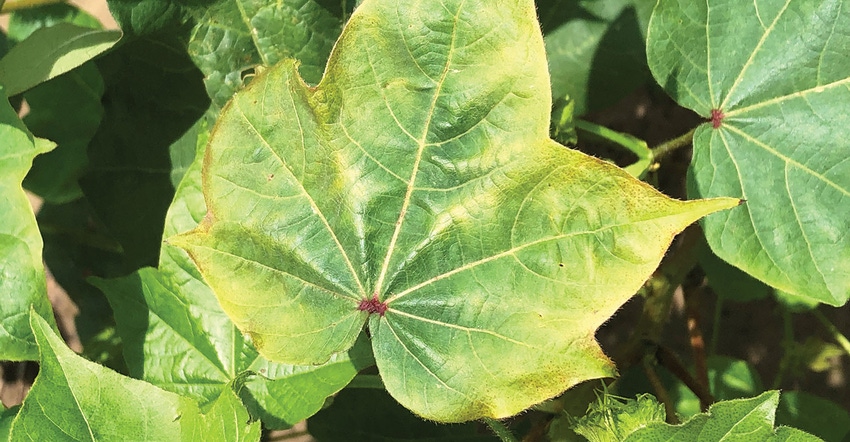
The initial reports of cotton leafroll dwarf virus (CLRDV) in Mississippi caught many farmers off guard during late 2018 and into the 2019 crop year. At the end of 2018, CLRDV had been positively detected in cotton plants from 13 Mississippi counties from Jackson County in the southeast to Tallahatchie County in the Delta. Following 2018, that was a pretty good distribution throughout the state.
Tom Allen, Extension and research plant pathologist with Mississippi State University, Stoneville, Miss., explains what he and other pathologists have learned so far concerning this cotton virus in Mississippi.
"At the Row Crop Short Course meeting last year, I presented information as it related to the late-season symptoms on cotton plants that had either been prepared for harvest or had recently been harvested and were exhibiting strange, abnormal regrowth."
Aphids main vector
Aphids are the main vector of the virus, and most plant viruses are vectored by an insect.
"Historically, this virus and plant-associated disease were first observed in Alabama in 2017," Allen said. "It is closely related to a cotton virus that occurs in South America, referred to as cotton blue disease, but we do not have cotton blue disease in the United States."
Unfortunately, you may hear this virus referred to as cotton blue disease, cotton leafroll dwarf virus, or cotton leafroll dwarf disease, which can cause tremendous confusion.
"One of the most important things to remember regarding plant diseases caused by a virus is that the virus infects a plant, and the plant expresses particular symptoms as a result of the virus; that’s the disease that occurs as a result of virus infection. Cotton leafroll dwarf virus causes the actual disease in the plant, cotton leafroll dwarf disease (CLRDD)," he said.
The bluish discoloration that can be observed in leaf tissue in some virus-infected plants is the main reason people refer to the disease as cotton blue disease. As of the end of 2019, Alabama, Florida, Georgia, Mississippi, South Carolina, Tennessee, and Texas have officially reported CLRDV-infected cotton.
"The hardest part to talk about as a plant pathologist tends to be that symptom expression associated with this particular virus may vary by variety," Allen said. "When different symptom expressions occur by variety it becomes hard to point out in a field and say with certainty that plants have cotton leafroll dwarf virus. I'll be the first person to admit there were some plants we collected in 2019 which, when we got the results back from the virologist, weren't cotton leafroll dwarf virus like we thought."
The easiest way to talk about CLRDV is to look at the differences in symptom expression between early and late-season symptoms. At the end of the 2018 season, plants that tested positive for CLRDV had symptoms that included taller than normal plants with stacked nodes in the upper canopy. However, pathologists knew those would likely not be the symptoms expressed first thing in the 2019 season.
"We have all had to spend a tremendous amount of time regrouping to determine what this virus looks like in young cotton," he said.
Early season symptoms
When attempting to diagnose the virus at the field level, the symptoms, that in some cases include yellow leaf margins on vegetative cotton plants as expressed early in 2019, may point to a problem other than CLRDV. In addition, the only way to positively confirm the presence of the virus in infected plant material is to conduct molecular analyses in a laboratory.
"The thing to bear in mind is you can have plants that may have a single symptom, more than one symptom, or, interestingly enough based on what the virologists have indicated, you can have plants that don't express any symptoms that test positive for this particular virus.
"In addition, plants may express symptoms associated with other disorders, and nutritional deficiency may actually exacerbate symptom expression associated with this particular plant virus. That makes it even more difficult to diagnose in the field."
In addition, plants can grow out of symptoms and no longer express visible symptoms of the virus in a short period of time which can make in-field diagnosis difficult.
Mid- to late season symptoms
"One thing we learned during the end of the season in 2018 was that infected plants would start to present strange growth habits, typically excessive growth in the upper part of the plant. Following that particular symptom into 2019, we started seeing excessive plant growth in the upper canopy in late July and early August. Plants expressed whip-like growth or were taller than normal plants in small areas of fields or single plants along edges," he said. "In 2019, whip-like symptoms started being observed throughout the Mississippi Delta about the time cotton reached cutout. A tremendous number of fields had this particular symptom. But, the hard part is, not all plants that express this symptom test positive for the virus."
Late in the season, additional symptoms included stacking of nodes and even brittle leaves in the upper canopy that crunched when grabbed in your hand. Some specific varieties were also observed to produce different symptoms such as strange vegetative growth from the bottom of the plant.
"Another symptom that we observed at the end of the season was folded-over leaves in the upper plant canopy," Allen said.
“The most important take-home message, at this point, is that CLRDV isn't presenting any huge yield losses."
About the Author(s)
You May Also Like




